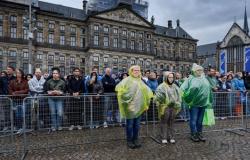‘Shop vacancy in inner cities is increasing’
3 min 55 sec
Of the approximately 31,000 stores, approximately 2,500 were empty in the first quarter, Colliers notes. That amounts to 433,000 square meters of retail space that is not being used. According to the real estate advisor, entrepreneurs face high costs, for example for wages, purchasing and rent. “This leads to bankruptcies or closure of some of the less active stores to save costs,” the report says.
One in ten shops is empty
Colliers looked at three different groups of cities in the five largest cities. “You can see that the percentage is not too bad, that is 6.1 percent,” says Van der Meer. ‘If you look at cities with more than 100,000 inhabitants, the figure is slightly higher at 8.5 percent and the problems only really arise in cities with 70,000 to 100,000 inhabitants. There that percentage is even 11 percent.’
Also read | Vacancy in shopping streets is increasing again
Competition
Smaller cities mainly suffer from competition from larger cities, where people move when they want to go shopping for a day. This is especially true in cities with 70,000 to 100,000 inhabitants, where a tenth of the shops are empty. Lelystad leads this group: in the Flevoland capital, almost a fifth of the shops are not rented. Colliers attributes this in part to the Batavia Stad outlet center, which is preferred by shoppers over the center of Lelystad.
‘Smaller cities mainly suffer from competition from larger cities’
‘If you look at cities such as Hengelo or Helmond, you will see that large cities such as Enschede and Eindhoven are nearby. And the consumer seeks out those cities (…). That does have a significant effect.’
Also read | For the first time in years, the supply of offices is growing: ‘Number of bankruptcies is increasing’
It is mainly large fashion stores, electronics stores and sports chains that are disappearing from city centers. According to Colliers, they no longer need many points of sale, now that many people can buy their things online. These companies often choose to set up one large sales point as a showroom in a major shopping street. ‘You also see a lot of delivery and takeaway businesses [uit de coronatijd] are also declining.’
Which stores are doing well? Van der Meer points out that people find ‘convenience and appearance really important’, ‘partly due to the influence of social media’. And that translates into more fast food stores, but also tattoo parlors, nail salons ‘and also second-hand clothing stores’.
Retail Policy
What can municipalities do to turn the tide? According to Van der Meer, it depends on a good municipal retail policy such as that pursued in Leeuwarden and Eindhoven. There, the expansion of retail space is not achieved through new construction, but through transformation. How? ‘Among other things, by relaxing zoning plans, making it easier to establish an entrepreneur in the city center.’






